-
How Free Trade Agreements Ignited U.S. Dairy Exports to 6 Countries
By USDEC January 28, 2016- Tweet
Mexico tops the list, showing a 558% increase over a 10-year period.
Editor's Note: This is the second of a two-part series examining a report on the impact of past Free Trade Agreements on the U.S. dairy industry. Also see, "Free Trade Agreements Helped Bring $8.3 Billion to U.S. Dairy Over 10 Years."
In the decade following implementation of the North American Free Trade Agreement (NAFTA), U.S. dairy exports to Mexico have increased from $250 million to $1.6 billion.
 That makes Mexico the U.S. dairy trading partner most positively affected by Free Trade Agreements between 2004 and 2014, according to a report by the U.S. Dairy Export Council and the National Milk Producers Federation.
That makes Mexico the U.S. dairy trading partner most positively affected by Free Trade Agreements between 2004 and 2014, according to a report by the U.S. Dairy Export Council and the National Milk Producers Federation.Overall, FTAs helped bring an additional $8.3 billion to the U.S. dairy industry from all countries studied during that period. That number includes increased dairy farmer income due to rising demand.
"Obviously, Free Trade Agreements have delivered in a big way for the U.S. dairy industry," said USDEC President Tom Suber. "Continued efforts are needed to forge new agreements, expand market access and stay competitive. Other dairy-exporting nations are trying to gain an advantage with their own agreements, so we can’t rest on our laurels."
USDEC and NMPF are still carefully examining the full text of a Trans-Pacific Partnership agreement released by the Obama administration, said Jaime Castaneda, senior vice president of trade policy at the U.S. Dairy Export Council. This study by USDEC and NMPF did not assess the potential impact of TPP.
The study did clearly show past Free Trade Agreements have been positive for the U.S. dairy industry.
The impact of entering into a Free Trade Agreement was estimated by comparing a trend projection based on exports prior to entering into the agreement with actual exports following implementation, said NMPF economist Peter Vitaliano, who conducted the study.
Based on dollar value of sales, here are the six countries most positively affected since Free Trade Agreements were implemented. Charts following this list show trade date from nine additional countries importing U.S. dairy products.

1. Mexico: After the implementation of the North American Free Trade Agreement (NAFTA) in 1994, U.S. dairy exports to Mexico (the largest U.S. dairy export destination) have increased by 558%. U.S. dairy and dairy products exports increased from totaling $250 million in 1993, to a total of $1.6 billion in 2014. The most significant growth in dairy product exports to this market was in non-fat dry milk, where U.S. exports increased from totaling $85 million in 1993 to a total of $775 million in 2014 (an increase of 809%).
U.S. exports to Mexico are fairly diverse. Although non-fat dry milk accounted for a sizable 47% of the total of U.S. dairy exports to Mexico last year, a majority of shipments were of a variety of other dairy products. Regular discussions between trade and regulatory officials have helped ensure a relatively smooth functioning of trade with this important FTA partner and provided a forum for resolving issues when they have at times arisen.

2. South Korea: For the U.S.-Korea Free Trade Agreement (KORUS), market access for dairy products took place through a combination of tariff elimination and expansion of TRQs. For dairy products, there was tariff reduction for some products but most products face expanding TRQs with phase out periods of 5-15 years. U.S. dairy exports to South Korea have increased from $223.7 million in 2011 (before the entry into force of the agreement in 2012) to $416 million in 2014, an increase of 86%.
Most of the growth has been in exports of “Cheese and Curd”, which represent 75% of U.S. dairy exports to this market and have increased by 116% from 2011 to 2014. The agreement, the first South Korea negotiated with a major dairy supplier, proved to be especially critical in ensuring that the U.S. did not lose ground competitively given that South Korea subsequently proceeded to negotiate FTAs with the EU, Australia and New Zealand, the U.S. dairy industry’s three major global competitors. Had the U.S. not had its own agreement in place, we could have been at risk of seeing a loss in market share rather than the significant export gains that have resulted from the agreement.
 3. Australia: The U.S.-Australia Free Trade Agreement (AUSFTA) entered into force on January 1, 2005. With this agreement over 99% of U.S. exports of consumer and industrial goods became duty-free. Since the inception of the agreement, U.S. dairy exports have increased 3,012%, from totaling $5.6 million in 2004 to total $173 million in 2014. The dairy product category that has seen the highest level of growth has been “Cheese and Curd” (which in 2014 represented 51% of total U.S. dairy exports to Australia), growing by 13,246% from 2004 to 2014.
3. Australia: The U.S.-Australia Free Trade Agreement (AUSFTA) entered into force on January 1, 2005. With this agreement over 99% of U.S. exports of consumer and industrial goods became duty-free. Since the inception of the agreement, U.S. dairy exports have increased 3,012%, from totaling $5.6 million in 2004 to total $173 million in 2014. The dairy product category that has seen the highest level of growth has been “Cheese and Curd” (which in 2014 represented 51% of total U.S. dairy exports to Australia), growing by 13,246% from 2004 to 2014.A key factor in the positive impact this agreement has had on the U.S. dairy industry has been not only how Australian dairy tariffs were handled, but also the care taken with how U.S. dairy tariffs were treated under the agreement. Additionally, it is important to note that a severe draught following the close of AUSFTA impacted trade dynamics between the U.S. and Australia by negatively impacting Australian production at a time when U.S. production was growing.

4. Singapore: U.S. dairy products enjoyed duty free access to the Singapore market even before the entry into force of the U.S.-Singapore FTA in 2004. However, trade has continued to expand in this market with U.S. dairy exports increasing from totaling $8.1 million in 2003 to $99.9 in 2014, an increase of 1,132%.

5. Morocco: Most dairy products under the U.S.-Morocco Free Trade Agreement (entered into force on January 1, 2006) have a duty elimination phase out period of 15 years. This means that they will be duty free by January 1, 2020. For dairy products, Morocco has been the FTA partner that has presented the highest level of growth on a proportional basis. U.S. dairy exports increased from totaling $64,499 in 2005 to total $97.1 million, an impressive increase of 150,437%. The main products exported to this market from the U.S. are whey (36% of U.S. dairy exports in 2014) and butter and milkfat (34%).

6. Chile: For the U.S.-Chile Free Trade Agreement, which entered into force on January 1, 2004, most tariffs for agricultural goods were almost completely eliminated, with the last year of the phase out period being 2015. U.S. dairy exports have increased from totaling $2.6 million in 2003 to totaling $60.2 million in 2014, an increase of 2,225% since the agreement’s implementation. 51% of the U.S. Dairy exports to Chile were in “Cheese and Curd”, which grew by 2,237% from 2003 to 2014.
The growth from such a minimum starting point helps illustrate the importance of cultivating markets over time, coupled with well-negotiated trade agreements. The expansion of U.S. dairy exports to Chile is all the more notable given that Chile is a competitive dairy producer in its own right. An important non-tariff element of the U.S.-Chile FTA was the establishment of a regulatory pathway for the U.S. to provide a list of plants intending to ship to Chile. This measure removed a regulatory barrier that had previously made it much more cumbersome in practice for U.S. dairy facilities to get approved by Chilean authorities to ship to Chile. This non-tariff element of the agreement was a critical factor in ensuring that U.S. companies would actually be able to take advantage of the opportunities that the elimination of tariffs introduced.
Data from more U.S. trading partners, listed alphabetically
The impact of FTAs goes beyond the six countries listed above.
The following charts show Vitaliano's estimates for incremental export sales (i.e., how much more than otherwise) that resulted from the respective Free Trade Agreements, both in total milk solids product volume and dollar value of sales. Here is his comprehensive country-by-country analysis:
Volume Increase in U.S. Dairy Export Sales of Key Dairy Products Due to Free Trade Agreements(Millions of lbs, milk equivalent, total milk solids basis)FTA Partner 2004 2005 2006 2007 2008 2009 2010 2011 2012 2013 2014 Australia 8 94 120 162 63 288 315 262 474 546 Bahrain 1 48 2 22 30 60 82 95 Chile 36 44 39 85 127 37 116 149 250 169 174 Colombia 22 27 154 Costa Rica 5 8 8 15 10 13 Dominican Republic 20 87 61 69 76 124 92 113 Honduras 46 0 51 5 10 28 43 21 Jordan 4 0 3 1 9 12 15 7 27 14 8 Mexico 528 789 577 1,248 1,541 1,371 1,860 2,448 2,755 2,696 3,110 Morocco 40 119 301 59 151 151 218 334 275 Nicaragua 11 4 28 Panama 50 16 Peru 0 111 43 131 100 94 Singapore 126 131 211 137 187 139 222 306 338 353 408 S. Korea 129 345 522 Grand Total 693 971 1,011 1,731 2,514 1,754 2,873 3,562 4,385 4,751 5,578 Dollar Increase in U.S. Dairy Export Sales of Key Dairy Products Due to Free Trade Agreements(Millions of dollars)FTA Partner 2004 2005 2006 2007 2008 2009 2010 2011 2012 2013 2014 Australia 0.5 6.0 18.8 24.2 5.5 35.6 60.1 69.7 100.3 132.2 Bahrain 0.3 8.9 0.8 5.4 8.2 17.2 24.3 24.8 Chile 3.4 3.7 4.0 13.5 21.5 5.4 19.3 31.3 51.2 40.6 44.3 Colombia 5.0 7.6 38.5 Costa Rica 0.6 1.4 1.8 3.8 2.7 4.3 Dominican Republic 3.0 15.8 9.6 12.9
17.4 26.7 25.9 31.4 Honduras 6.3 10.8 0.9 2.0 5.9 9.6 5.8 Jordan 0.9 0.4 0.4 2.5 1.8 3.5 2.5 6.1 4.5 2.9 Mexico 64.6 103.6 75.7 244.0 318.8 200.3 314.6 498.9 562.6 641.3 766.5 Morocco 3.8 17.4 47.1 7.3 30.3 36.4 45.2 74.2 61.7 Nicaragua 2.0 0.8 5.2 Panama 15.7 5.7 Peru 17.3 8.8 25.2 21.9 22.5 Singapore 10.4 13.3 17.7 21.4 26.4 15.1 28.4 56.8 68.5 69.1 79.1 S. Korea 30.5 85.2 150.2 Grand Total 79 121 114 319 476 247 471 728 923 1,114 1,375 Learn more about Free Trade Agreements:
- Free Trade Agreements Helped Bring $8.3 Billion to U.S. Dairy Over 10 Years
- Statement from NMPF and USDEC on Release of Full Text of Trans-Pacific Partnership Agreement
- Pros and Cons of TPP for U.S. Dairy Industry
- U.S. Dairy Industry Needs to See TPP Details
- 3 Ways U.S. Korea Trade Agreement Has Helped U.S. Dairy
- Trade Agreements Deliver for the U.S. Dairy Industry
To download a printable pdf version of the joint report by USDEC and NMPF on the impact of free trade agreements, click here.
Subscribe to the U.S. Dairy Exporter Blog
The U.S. Dairy Export Council fosters collaborative industry partnerships with processors, trading companies and others to enhance global demand for U.S. dairy products and ingredients. USDEC is primarily supported by Dairy Management Inc. through the dairy farmer checkoff. How to republish this post.
10 Most Recent Posts
Most Popular Posts in Past Year
Index of Posts by Topic
- #GotDairyJobs (4)
- About USDEC (66)
- Africa (6)
- Australia (4)
- Blog (8)
- Brazil (4)
- Canada (20)
- Central America (1)
- Cheese (58)
- Chile (1)
- China (54)
- Common food names (7)
- Company News (20)
- Consistent Supply (1)
- Crisis Management (3)
- Cuba (2)
- Dairy (6)
- Dairy checkoff (9)
- Dairy Ingredients (5)
- Dairy Management Inc. (2)
- Dairy Resources (1)
- Dairy Supply Chain (1)
- Dairy Trends (5)
- Documentation (3)
- EU (24)
- Experts on Dairy Exports (4)
- Exporter of the Year (2)
- Exports (24)
- Farmer leaders (1)
- Farming (38)
- Food Aid (8)
- Food Safety (8)
- Foodservice (3)
- Free trade agreements (34)
- Future trends (1)
- Geographical Indications (GIs) (10)
- Global Marketing (86)
- Global Shipping Crisis (1)
- Got Jobs? (9)
- Indonesia (1)
- Innovation (17)
- Japan (17)
- Krysta Harden (1)
- Market Access (25)
- Market Conditions (268)
- Member Services (17)
- Mexico (41)
- Middle East (9)
- Middle East & North Africa (3)
- Middle East/North Africa (9)
- Milk (4)
- Milk Protein Concentrate (MPC) (2)
- New Zealand (11)
- Next5% (20)
- Nonfat Dry Milk/Skim Milk Powder (8)
- Nutrition (19)
- Product Innovation (6)
- Protein (4)
- Regulations (5)
- Research & Data (326)
- Russia (3)
- Singapore (10)
- South America (8)
- South Korea (10)
- Southeast Asia (25)
- Strategic Insights (1)
- Supply (1)
- Sustainability (26)
- Technology (2)
- ThinkUSADairy (5)
- TPM23 (1)
- TPP (13)
- Traceability (8)
- Trade Barriers (5)
- Trade Data (7)
- Trade Policy (72)
- TTIP (5)
- UHT Milk (7)
- USMCA (2)
- Vietnam (4)
- Whey (6)
- Whey Ingredients (2)
- Whey products (10)
- Whole Milk Powder (WMP) (3)
- World Dairy Expo (1)
- World Milk Day (1)
- Yogurt (1)
Index of Posts by Date, Author
- June 2021 (13)
- March 2015 (12)
- September 2015 (12)
- April 2015 (11)
- December 2015 (11)
- March 2014 (10)
- February 2015 (10)
- October 2015 (10)
- October 2014 (9)
- June 2015 (9)
- July 2015 (9)
- November 2015 (9)
- March 2016 (9)
- October 2019 (9)
- September 2013 (8)
- May 2015 (8)
- August 2015 (8)
- January 2016 (8)
- February 2016 (8)
- March 2017 (8)
- December 2018 (8)
- May 2019 (8)
- December 2019 (8)
- June 2014 (7)
- November 2016 (7)
- May 2017 (7)
- May 2018 (7)
- July 2020 (7)
- June 2023 (7)
- July 2016 (6)
- August 2018 (6)
- October 2018 (6)
- November 2018 (6)
- February 2019 (6)
- June 2019 (6)
- August 2019 (6)
- March 2020 (6)
- April 2020 (6)
- June 2020 (6)
- June 2022 (6)
- February 2014 (5)
- June 2016 (5)
- August 2016 (5)
- September 2016 (5)
- December 2016 (5)
- February 2017 (5)
- July 2017 (5)
- October 2017 (5)
- January 2018 (5)
- April 2018 (5)
- June 2018 (5)
- July 2018 (5)
- September 2018 (5)
- January 2019 (5)
- March 2019 (5)
- April 2019 (5)
- July 2019 (5)
- September 2019 (5)
- November 2019 (5)
- January 2020 (5)
- August 2020 (5)
- October 2020 (5)
- April 2021 (5)
- January 2022 (5)
- May 2013 (4)
- September 2014 (4)
- April 2016 (4)
- May 2016 (4)
- October 2016 (4)
- January 2017 (4)
- April 2017 (4)
- June 2017 (4)
- August 2017 (4)
- September 2017 (4)
- December 2017 (4)
- February 2018 (4)
- February 2020 (4)
- May 2020 (4)
- February 2022 (4)
- September 2022 (4)
- April 2023 (4)
- December 2023 (4)
- November 2017 (3)
- March 2018 (3)
- September 2020 (3)
- December 2020 (3)
- February 2021 (3)
- May 2021 (3)
- August 2021 (3)
- December 2021 (3)
- March 2022 (3)
- April 2022 (3)
- May 2022 (3)
- October 2022 (3)
- December 2022 (3)
- May 2023 (3)
- July 2023 (3)
- November 2023 (3)
- March 2011 (2)
- June 2011 (2)
- September 2011 (2)
- March 2012 (2)
- June 2012 (2)
- July 2012 (2)
- March 2013 (2)
- July 2013 (2)
- November 2020 (2)
- January 2021 (2)
- March 2021 (2)
- July 2021 (2)
- September 2021 (2)
- October 2021 (2)
- November 2021 (2)
- July 2022 (2)
- August 2022 (2)
- January 2023 (2)
- March 2023 (2)
- October 2023 (2)
- January 2024 (2)
- February 2024 (2)
- April 2024 (2)
- June 2024 (2)
- July 2024 (2)
- November 2024 (2)
- December 2024 (2)
- February 2025 (2)
- June 2025 (2)
- July 2025 (2)
- September 2025 (2)
- November 2025 (2)
- December 2025 (2)
- January 2010 (1)
- February 2010 (1)
- March 2010 (1)
- April 2010 (1)
- May 2010 (1)
- June 2010 (1)
- July 2010 (1)
- August 2010 (1)
- September 2010 (1)
- October 2010 (1)
- November 2010 (1)
- December 2010 (1)
- January 2011 (1)
- February 2011 (1)
- April 2011 (1)
- May 2011 (1)
- July 2011 (1)
- August 2011 (1)
- October 2011 (1)
- November 2011 (1)
- December 2011 (1)
- January 2012 (1)
- February 2012 (1)
- April 2012 (1)
- August 2012 (1)
- September 2012 (1)
- October 2012 (1)
- November 2012 (1)
- December 2012 (1)
- January 2013 (1)
- February 2013 (1)
- April 2013 (1)
- June 2013 (1)
- August 2013 (1)
- October 2013 (1)
- November 2013 (1)
- December 2013 (1)
- January 2014 (1)
- April 2014 (1)
- May 2014 (1)
- November 2022 (1)
- February 2023 (1)
- August 2023 (1)
- September 2023 (1)
- March 2024 (1)
- May 2024 (1)
- August 2024 (1)
- September 2024 (1)
- October 2024 (1)
- January 2025 (1)
- March 2025 (1)
- April 2025 (1)
- May 2025 (1)
- August 2025 (1)
- USDEC (183)
- USDEC Staff (164)
- Alan Levitt (119)
- Tom Suber (41)
- Margaret Speich (22)
- Marc A.H. Beck (15)
- Vikki Nicholson-West (11)
- Angélique Hollister (11)
- Tom Vilsack (8)
- Jaime Castaneda (7)
- Matt McKnight (7)
- Véronique Lagrange (7)
- Margaret Speich and Mark O'Keefe (7)
- Ross Christieson (7)
- Paul Rogers (6)
- Shawna Morris (5)
- William Loux (5)
- Alan Levitt and Marc Beck (5)
- Krysta Harden (4)
- USDEC Communications (3)
- Kristi Saitama (3)
- Marilyn Hershey (3)
- Brad Gehrke (3)
- Tom Quaife (2)
- Nick Gardner (2)
- Jim Mulhern (2)
- Alan Levitt and William Loux (2)
- Kara McDonald (2)
- Luke Waring (2)
- Merle McNeil (2)
- Andrei Mikhalevsky (1)
- Rodrigo Fernandez (1)
- Dermot Carey (1)
- Jeremy Travis (1)
- Annie Bienvenue (1)
- Ross Christieson and Shawna Morris (1)
- Becky Nyman (1)
- Paul Rogers and Tom Quaife (1)
- Rick Ortman (1)
- Tony Rice (1)
- Barbara O’Brien (1)
- Paul Rogers and Mark O'Keefe (1)
- Dalilah Ghazalay (1)
- Amy Wagner (1)
- Mitchell Bowling (1)
- Erica Louder (1)
- Brad Scott (1)
- Amy Foor (1)
- Scott Lantz (1)
- Sandra Benson (1)
- Errico Auricchio (1)
- Jaclyn Krymowski (1)
- Krysta Harden, USDEC President and CEO (1)
.png)

